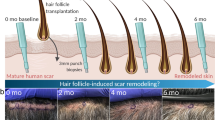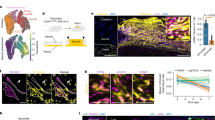Abstract
Understanding molecular mechanisms for regeneration of hair follicles provides new opportunities for developing treatments for hair loss and other skin disorders. Here we show that fibroblast growth factor 9 (Fgf9), initially secreted by γδ T cells, modulates hair follicle regeneration after wounding the skin of adult mice. Reducing Fgf9 expression decreases this wound-induced hair neogenesis (WIHN). Conversely, overexpression of Fgf9 results in a two- to threefold increase in the number of neogenic hair follicles. We found that Fgf9 from γδ T cells triggers Wnt expression and subsequent Wnt activation in wound fibroblasts. Through a unique feedback mechanism, activated fibroblasts then express Fgf9, thus amplifying Wnt activity throughout the wound dermis during a crucial phase of skin regeneration. Notably, humans lack a robust population of resident dermal γδ T cells, potentially explaining their inability to regenerate hair after wounding. These findings highlight the essential relationship between the immune system and tissue regeneration. The importance of Fgf9 in hair follicle regeneration suggests that it could be used therapeutically in humans.
This is a preview of subscription content, access via your institution
Access options
Subscribe to this journal
Receive 12 print issues and online access
$209.00 per year
only $17.42 per issue
Buy this article
- Purchase on Springer Link
- Instant access to full article PDF
Prices may be subject to local taxes which are calculated during checkout






Similar content being viewed by others
References
Ito, M. et al. Wnt-dependent de novo hair follicle regeneration in adult mouse skin after wounding. Nature 447, 316–320 (2007).
Breedis, C. Regeneration of hair follicles and sebaceous glands from the epithelium of scars in the rabbit. Cancer Res. 14, 575–579 (1954).
Gurtner, G.C., Werner, S., Barrandon, Y. & Longaker, M.T. Wound repair and regeneration. Nature 453, 314–321 (2008).
Jameson, J. et al. A role for skin γδ T cells in wound repair. Science 296, 747–749 (2002).
Sharp, L.L., Jameson, J.M., Cauvi, G. & Havran, W.L. Dendritic epidermal T cells regulate skin homeostasis through local production of insulin-like growth factor 1. Nat. Immunol. 6, 73–79 (2005).
Toulon, A. et al. A role for human skin-resident T cells in wound healing. J. Exp. Med. 206, 743–750 (2009).
Workalemahu, G., Foerster, M. & Kroegel, C. Expression and synthesis of fibroblast growth factor-9 in human γδ T lymphocytes. Response to isopentenyl pyrophosphate and TGF-β1/IL-15. J. Leukoc. Biol. 75, 657–663 (2004).
Prinz, I. et al. Visualization of the earliest steps of γδ T cell development in the adult thymus. Nat. Immunol. 7, 995–1003 (2006).
Cai, Y. et al. Pivotal role of dermal IL-17–producing γδ T cells in skin inflammation. Immunity 35, 596–610 (2011).
Sumaria, N. et al. Cutaneous immunosurveillance by self-renewing dermal γδ T cells. J. Exp. Med. 208, 505–518 (2011).
Kim, C.H., Witherden, D.A. & Havran, W.L. Characterization and TCR variable region gene use of mouse resident nasal γδ T lymphocytes. J. Leukoc. Biol. 84, 1259–1263 (2008).
Yin, Y. et al. An FGF-WNT gene regulatory network controls lung mesenchyme development. Dev. Biol. 319, 426–436 (2008).
Yin, Y., Wang, F. & Ornitz, D.M. Mesothelial- and epithelial-derived FGF9 have distinct functions in the regulation of lung development. Development 138, 3169–3177 (2011).
Chen, D., Jarrell, A., Guo, C., Lang, R. & Atit, R. Dermal β-catenin activity in response to epidermal Wnt ligands is required for fibroblast proliferation and hair follicle initiation. Development 139, 1522–1533 (2012).
Ornitz, D.M. et al. Receptor specificity of the fibroblast growth factor family. J. Biol. Chem. 271, 15292–15297 (1996).
Hendrix, N.D. et al. Fibroblast growth factor 9 has oncogenic activity and is a downstream target of Wnt signaling in ovarian endometrioid adenocarcinomas. Cancer Res. 66, 1354–1362 (2006).
Ebert, L.M., Meuter, S. & Moser, B. Homing and function of human skin γδ T cells and NK cells: relevance for tumor surveillance. J. Immunol. 176, 4331–4336 (2006).
Bos, J.D. et al. T cell receptor γδ bearing cells in normal human skin. J. Invest. Dermatol. 94, 37–42 (1990).
Bos, J.D. et al. The skin immune system (SIS): distribution and immunophenotype of lymphocyte subpopulations in normal human skin. J. Invest. Dermatol. 88, 569–573 (1987).
Foster, C.A. et al. Human epidermal T cells predominantly belong to the lineage expressing α/β T cell receptor. J. Exp. Med. 171, 997–1013 (1990).
Gray, E.E., Suzuki, K. & Moser, J.G. Identification of a motile IL-17–producing γδ T cell population in the dermis. J. Immunol. 186, 6091–6095 (2011).
Clark, R.A. et al. The vast majority of CLA+ T cells are resident in normal skin. J. Immunol. 176, 4431–4439 (2006).
Huelsken, J., Vogel, R., Erdmann, B., Cotsarelis, G. & Birchmeier, W. β-catenin controls hair follicle morphogenesis and stem cell differentiation in the skin. Cell 105, 533–545 (2001).
Zhang, Y. et al. Reciprocal requirements for EDA/EDAR/NF-κB and Wnt/β-catenin signaling pathways in hair follicle induction. Dev. Cell 17, 49–61 (2009).
Reddy, S. et al. Characterization of Wnt gene expression in developing and postnatal hair follicles and identification of Wnt5a as a target of Sonic hedgehog in hair follicle morphogenesis. Mech. Dev. 107, 69–82 (2001).
Huang, S. et al. Wls is expressed in the epidermis and regulates embryonic hair follicle induction in mice. PLoS ONE 7, e45904 (2012).
Wells, K.L. et al. Genome-wide SNP scan of pooled DNA reveals nonsense mutation in FGF20 in the Scaleless line of featherless chickens. BMC Genomics 13, 257 (2012).
Widelitz, R.B., Jiang, T.X., Lu, J. & Chuong, C.M. β-catenin in epithelial morphogenesis: conversion of part of avian foot scales into feather buds with a mutated β-catenin. Dev. Biol. 219, 98–114 (2000).
Huh, S.H. et al. Fgf20 governs formation of primary and secondary dermal condensations in developing hair follicles. Genes Dev. 27, 450–458 (2013).
Livak, K.J. & Schmittgen, T.D. Analysis of relative gene expression data using real-time quantitative PCR and the 2−ΔΔCt method. Methods 25, 402–408 (2001).
Nguyen, H., Rendl, M. & Fuchs, E. Tcf3 governs stem cell features and represses cell fate determination in skin. Cell 127, 171–183 (2006).
White, A.C. et al. FGF9 and SHH signaling coordinate lung growth and development through regulation of distinct mesenchymal domains. Development 133, 1507–1517 (2006).
Lin, Y., Liu, G. & Wang, F. Generation of an Fgf9 conditional null allele. Genesis 44, 150–154 (2006).
Lustig, B. et al. Negative feedback loop of Wnt signaling through upregulation of conductin/axin2 in colorectal and liver tumors. Mol. Cell Biol. 22, 1184–1193 (2002).
Ito, M. et al. Stem cells in the hair follicle bulge contribute to wound repair but not to homeostasis of the epidermis. Nat. Med. 11, 1351–1354 (2005).
Shi, G. et al. Expression of paired-like homeodomain transcription factor 2c (PITX2c) in epidermal keratinocytes. Exp. Cell Res. 316, 3263–3271 (2010).
Braissant, O. & Wahli, W. A simplified in situ hybridization protocol using non–radioactively labeled probes to detect abundant and rare mRNAs on tissue sections. Biochemica 1, 11–16 (1998).
Andrew, E.M. et al. Delineation of the function of a major γδ T cell subset during infection. J. Immunol. 175, 1741–1750 (2005).
Acknowledgements
We thank R.L. O'Brien for thoughtful reading of the manuscript, P. Coulombe (Johns Hopkins University) for providing K17-specific antisera and members of A. Bhandoola's laboratory and The University of Pennsylvania Flow Cytometry and Cell Sorting Resource Laboratory for assistance with cell-sorting experiments. We also thank J. Tobias and D. Baldwin of the Penn Microarray Core Facility, L. Ash of the Dermatology Department Histology Core and the Penn Human Cooperative Tissue Network. Funding was provided by US National Institutes of Health (NIH) grant R01-AR46837, NIH Skin Diseases Research Core grant P30-AR057217, the Edwin and Fannie Gray Hall Center for Human Appearance at University of Pennsylvania Medical Center and The Dermatology Foundation. This work was also supported by NIH grant 5RO1 AR055309-4 and, for D.M.O., grant R01 HL105732. P.D.H. is supported by NIH training grant 5T32AR007465-29.
Author information
Authors and Affiliations
Contributions
D.G., O.K. and G.C. designed the studies and analyzed and interpreted the results with assistance from Z.Z., M.S., P.D.H., Z.Y., E.T., C.D.K., A.N., X.Z. and S.B. D.G. wrote and D.G and G.C. edited the manuscript. M.V.P., P.D.H., M.I., F.W., D.M.O. and S.E.M. provided theoretical and technical advice and assistance. F.W. and D.M.O. provided TRE-Fgf9-IRES-EGFP and Fgf9fl/fl mice, and S.E.M. provided Krt14-Wnt7a mice. D.M.O. provided pGEM-Fgf9 plasmid.
Corresponding author
Ethics declarations
Competing interests
O.S.K. and G.C. are co-inventors on a patent application filed through the World Patent Organization by the University of Pennsylvania describing the Fgf9 pathway as a target for promoting hair growth, among other claims. It is currently being prosecuted in multiple countries.
Supplementary information
Supplementary Text and Figures
Supplementary Figures 1–7 (PDF 17529 kb)
Rights and permissions
About this article
Cite this article
Gay, D., Kwon, O., Zhang, Z. et al. Fgf9 from dermal γδ T cells induces hair follicle neogenesis after wounding. Nat Med 19, 916–923 (2013). https://doi.org/10.1038/nm.3181
Received:
Accepted:
Published:
Issue Date:
DOI: https://doi.org/10.1038/nm.3181
This article is cited by
-
The efficacy of adipose-derived stem cells in burn injuries: a systematic review
Cellular & Molecular Biology Letters (2024)
-
Deciphering the molecular mechanisms of stem cell dynamics in hair follicle regeneration
Experimental & Molecular Medicine (2024)
-
Tracing immune cells around biomaterials with spatial anchors during large-scale wound regeneration
Nature Communications (2023)
-
Epidermal–dermal coupled spheroids are important for tissue pattern regeneration in reconstituted skin explant cultures
npj Regenerative Medicine (2023)
-
Developmentally programmed early-age skin localization of iNKT cells supports local tissue development and homeostasis
Nature Immunology (2023)



